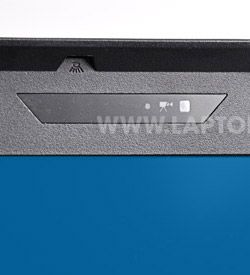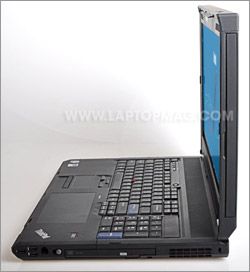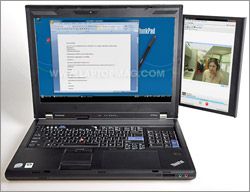Laptop Mag Verdict
Is a quad-core processor, built-in digitizer, and color-calibrator not enough innovation for you? Lenovo also crams in a slide-out second display into this behemoth workstation.
Pros
- +
Handy secondary display
- +
Incredible power
- +
Integrated digitizer
- +
Good ergonomics
Cons
- -
Very heavy and thick
- -
Short battery life
- -
Expensive
Why you can trust Laptop Mag
Editors' Note: Parts of this article were taken from our previous reviews of theLenovo ThinkPad W700and theW700 with a quad core processor.
This past fall, Lenovo released the most powerful desktop replacement we'd ever tested: the 17-inch W700. A few weeks later, we were able to review an even more powerful version with a mobile quad-core processor. Now comes yet another member of the W700 family with a groundbreaking new feature, a second display that extends from the lid to give mobile users a true multi-monitor experience. Though extremely expensive and heavy, the ThinkPad W700ds--which checks in $5,100 and 11 pounds--offers a complete workstation with all the power and creature comforts of a high-end desktop in a transportable package.
Design and (ahem) Portability
There's no mistaking the familiar matte black finish of a ThinkPad, and despite its size, the W700ds maintains that look. The super-sized system measures 16.1 x 12.2 x 2.1 inches and weighs a full 11 pounds, which is 0.5 inches thicker and 2.2 pounds heavier than its single-screen sibling. Its power brick, too, is one of the biggest and heaviest we've seen, measuring 6.7 x 3.3 x 1.5 inches and weighing 2.2 pounds.
The heavy, thick system poses several challenges for those who would carry it. Not only does the combination of the power brick and the notebook itself exceed 13 pounds, but the chunky chassis won't squeeze into most notebook bags. After going through a closet full of new laptop cases, we were unable to find a single one that would zip closed with the W700ds inside. Fortunately,Lenovo sells a large-enough case for $63.20.
Forget about cramped airline trays or tiny coffee shop tables. To use the W700ds, you need some room to spread out. And unless you've played center for an NBA team, don't even think about placing this PC on your lap.

Click to enlargeSo why would you want to buy a ThinkPad W700ds, when a similarly-equipped desktop with two full-size monitors would cost several thousand dollars less? The ThinkPad provides an opportunity to put the entire desktop experience--full keyboard, Wacom tablet, dual screens, and all--in an (admittedly large) bag and take it with you. Photographers and filmmakers, who are used to lugging heavy equipment with them on-location, won't even notice the system's size. Workers who find themselves setting up shop for weeks at a time in different cities will be able to take the W700ds with them, much more easily than the combination of a desktop, keyboard, mouse, tablet, and two monitors.
In offices where users never take their computers home, the W700ds uses less desk space than a desktop. Despite its powerful components, it uses less electricity as well.
Keyboard and Touchpad
The W700ds' deck has plenty of space. It's outfitted with the classic ThinkPad keyboard, which is roomy and comfortable and includes a separate number pad to the right. ThinkPad fans can opt to use the familiar pointing stick or the touchpad for cursor control. Both are responsive and easy to reach, but the touchpad is quite small.

Click to enlarge
Built-in Tablet and Color Calibrator
To the right of the touchpad is a 5.1 x 3.2-inch Wacom digitizer pad, which comes with a stylus pen that can be stashed away in its holder on the right side of the system. The pad felt a bit too sensitive at first, but after using the Tablet PC Pen Training utility we used the pad and stylus as a mouse controller with relative ease. It also took a few tries to get the handwriting recognition feature to recognize our penmanship, but after 15 minutes or so of practice (also in the Tablet PC Pen Training utility) we could write full sentences without any recognition errors. Still, it's a tedious process that requires patience to be used effectively.
We used the digitizer to touch up a picture in Photoshop and to draw a sketch in Microsoft Paint. In both cases, the digitizer performed well, registering inputs accurately both in terms of speed and pressure. However, using the lower part of the pad proved more difficult; its location on the deck made us unable to rest our hand on the notebook itself. This isn't an issue with a traditional digitizer, which has a low profile, but on the W700ds, it's 1.3 inches above the desk, making it less comfortable.
Primary Display
Under the lid sits an eye-popping, 17-inch display with a 1920 x 1200-pixel resolution. Color reproduction and viewing angles on this screen are excellent, thanks to the use of wide-ranging technology, which allows the panel to display 72 percent of the NTSC color space, resulting in a more colorful image. (Most notebook screens display around 45 percent of the NTSC color space).

Click to enlarge
Secondary Display
The right side of the W700ds' lid conceals another screen that pops out when pressed and can bend to sit parallel or at 45-degree angle to the primary display. At just 10.6 inches, this secondary, portrait-mode LCD provides valuable extra real estate, but won't make you forget about its 17-inch companion.
With a native resolution of 1280 x 768, the screen is long enough but too narrow to comfortably surf the Web. Lenovo promotes the second screen as a perfect place to put toolboxes--like those found in Photoshop--while you edit a large image on the primary display. The secondary display was equally perfect for keeping e-mail and IM chat windows visible at all times. We were able to conduct a video call with Skype on the secondary display while we worked on other tasks in the main window. The second screen can also serve as a miniature television, showing online videos while you work. Unfortunately, the vertical orientation of the LCD means that most videos will only take up about a third of the available vertical space.
The image quality on the secondary display was acceptable but not as strong as on its larger counterpart. Images, and even the desktop wallpaper, were significantly duller and dimmer. The viewing angles are not as wide, but positioning the bendable display so that it sits at a 45-degree angle to the lid improves the experience for users who are sitting directly in front of the main screen. Tilting the secondary display inward also prevents users from having to crane their necks.
Multimedia
When we started up our There Will Be Blood disc in the 8X DVDRW drive, we were treated to bright and crisp images but were disappointed to see uneven, stuttering playback when we expanded the InterVideo WinDVD 5 window to full-screen. However, the movie played flawlessly in Windows Media Player 11. If high-definition video is more to your liking, Lenovo offers a Blu-ray burner for an additional $382.

Click to enlargeWebcam
Above the display is a 1.3-megapixel webcam, which uses the included Roxio Media Import application to display and capture video and photos. The camera is adequate for video chats and e-mailing photos, but its image quality was fairly grainy.
Color Calibrator
For photographers, graphic artists, and others who require a consistent and reliable degree of color accuracy, the W700ds contains a built-in color calibrator. Using a small sensor embedded in the keyboard deck and Pantone's huey Pro color-control software, the device scans the primary screen while the lid is closed; it sounds three tones when the calibration process is complete. We calibrated the screen in just under a minute and immediately noticed a marked improvement. Colors appeared much bolder, and the panel exhibited much deeper black levels than before the calibration.
Ports, Slots, and Security
Connectivity options abound on the W700: five USB ports, dual-link DVI, VGA, FireWire, DisplayPort, ExpressCard/34 and Compact Flash slots, a 7-in-1 card reader, and Ethernet, modem, headphone, and microphone jacks.

Click to enlarge
Security features include a fingerprint reader, integrated TPM 1.2 circuitry, and Lenovo's ThinkVantage Client Security Password Manager utility. The system can also be ordered with an optional Smart Card reader for added protection. A Mini Dock ($279) is also available, for connecting to a variety of external devices such as a keyboard mouse and eSATA storage devices.

Click to enlargePerformance
Powered by Intel's QX9300 quad-core engine and 4GB of memory (expandable to 8GB), the W700ds obliterated all previous PCMark Vantage scores with a mark of 5,296, which is nearly 2,000 points above the desktop replacement average. In fact, the only notebook to top this score was the quad-core W700, which notched a score of 5,352.
To see the difference between quad-core and dual-core performance,refer to our earlier W700 review. However, it should be noted that there aren't many programs that currently make use of four cores. Intel counts more than 30 programs (and growing), including mainstream content-creation applications (Corel Video Studio X2, CyberLink Power Director 7), professional content-creation apps (Adobe After Effects CS4, Adobe Photoshop CS3, Sony Vegas v8.0b), and games (Hellgate: London, Far Cry 2, and Unreal Tournament 3).
Hard Drive Performance and Boot Time
The system's dual 7,200-rpm, 160GB Seagate Momentus hard drives (set to RAID 0) managed a speedy throughput of 33.3 MBps on the LAPTOP Transfer Test (copying a 4.97GB folder of mixed media)--a full 11 MBps above the category average. In synthetic benchmark SiSoftware Sandra, the drives returned a solid transfer rate of 72.6 MBps with a seek time of 15ms. Customers can also configure the system with dual drives up to 320GB in capacity, as well as 64GB Samsung SSDs. The system booted the 64-bit version of Windows Vista Business in 69 seconds, about a second below the desktop replacement average.
Graphics Performance
Workstations are expected to be graphics dynamos, and the W700ds didn't disappoint. Packing a high-powered Nvidia Quadro FX 3700M graphics chipset (with 1GB of dedicated video memory), it crushed all other non-gaming desktop replacements with a super-charged 11,256 on our 3DMark06 benchmark (which tests DirectX 9, CPU, and 3D features). That's twice as fast as the category average, but about 800 points less than the current GPU champ, theAlienware Area-51 m17x. On our 3DMark Vantage test (which measures DirectX 10, Shader Model 4.0, and multi-threading capability), the W700ds produced a score of 5,035, which trounced even the m17x by about 1,100 points.
As expected from the benchmark numbers, the W700ds came up aces when we fired up F.E.A.R. in autodetect mode (1024 x 768-pixel resolution), it managed an amazingly smooth 79 frames per second. When set to its native 1920 x 1200-pixel resolution and with effects maxed out, the W700ds managed 51 fps. The W700ds also maintained a smooth 86.7 frames per second in Far Cry 2, so if you want to game, this is a more-than-capable machine.

Click to enlargeWi-Fi and Mobile Broadband Connectivity
The integrated Intel WiFi Link 5300 provided good wireless throughput with speeds of 19.8 and 18.6 Mbps at 15 and 50 feet from the access point, respectively. While the 15-foot score is just above the category average, its speed at 50 feet is 3.0 Mbps better than other desktop replacements. Those seeking mobile broadband can configure the W700ds with an integrated WiMAX card, though our review unit did not come with one.
Battery Life
Given the size of the W700ds, it's doubtful you'll venture too far from an outlet and, considering its poor endurance, you won't be able to, anyway. On the LAPTOP Battery Test (continuous Web surfing over Wi-Fi), the system's nine-cell battery lasted a mere 1 hour and 43 minutes, which is an hour and 4 minutes less than the average desktop replacement. The second screen, which we kept open throughout our test, might be to blame, because the similarly speced quad-core W700 lasted 2 hours and 50 minutes.

Click to enlargeVerdict
Like previous W700s, the Lenovo ThinkPad W700ds incorporates a slew of innovative features, but its secondary display is truly groundbreaking. Exact pricing has not yet been set, but our configuration is valued at close to $4,600 without the secondary screen, and Lenovo said that the second screen will come with a $500 premium. You can bring the cost down by hundreds of dollars and still get the secondary display if you configure the system with a dual-core CPU, a slower graphics chip, and a single hard drive.
So is a 10.6-inch screen worth an extra $500 when 19-inch external monitors can be had for $100? It is if you need to take that screen with you to a work site and you can't pack an external monitor in a carton. As mobile components become less expensive, we expect the prices of high-performance notebooks like this one to come closer to those of similarly configured desktops. If you need that kind of mobile horsepower and versatility today, the W700ds is worth every penny.
[flq:a32598e439e22a0ff90289ff0028edc5]
Lenovo ThinkPad W700ds Specs
| Bluetooth | Bluetooth 2.0 |
| Brand | Lenovo |
| CPU | 2.53-GHz Core 2 Quad Core Extreme QX9300 |
| Card Slots | 7-1 card reader, ExpressCard |
| Company Website | http://www.lenovo.com/us |
| Display Size | 17 |
| Graphics Card | Nvidia Quadro FX 3700M |
| Hard Drive Size | 320GB |
| Hard Drive Speed | 7,200rpm |
| Hard Drive Type | SATA Dual Drive |
| Native Resolution | 1920x1200 |
| Operating System | MS Windows Vista Business |
| Optical Drive Speed | 8X |
| Ports (excluding USB) | Firewire, Ethernet, Docking Connector, DisplayPort, Modem, DVI, Microphone, Compact Flash, Headphone |
| RAM | 4GB |
| RAM Upgradable to | 8GB |
| Size | 16.1 x 12.2 x 2.1 inches |
| USB Ports | 5 |
| Video Memory | 1GB |
| Weight | 11 pounds |
| Wi-Fi | 802.11a/g/n |
